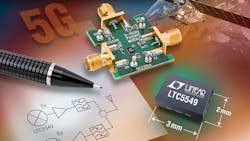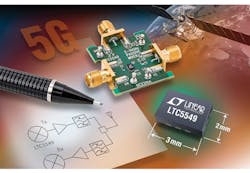Double-Balanced Microwave Mixer Translates 2 to 14 GHz
This file type includes high resolution graphics and schematics when applicable.
Frequency conversion is an essential function within receivers and transmitters for untold high-frequency applications. Looking to bolster this capability, Linear Technology developed the LTC5549 microwave mixer, which provides RF/microwave designers with greater degrees of performance and flexibility.
Housed in a compact QFN package, this broadband mixer operates from 2 to 14 GHz and can perform both frequency upconversion and downconversion, to serve both transmitters and receivers, respectively. It’s suitable for a wide range of systems and designs, including wireless base stations, satellite-communications (satcom) systems, radar, and test equipment.
The model LTC5559 (see the figure) maintains an RF range of 2 to 14 GHz, a local-oscillator (LO) frequency range of 1 to 12 GHz, and an intermediate-frequency (IF) range of 0.5 to 6.0 GHz. All three mixer ports are matched to 50-⦠impedance. The device maintains low conversion loss across its broad frequency range, with typically 7.8-dB conversion loss for an RF of 2 GHz and an LO of 3.89 GHz and 9.4-dB conversion loss for an RF of 9 GHz and an LO frequency of 7.11 GHz.
For temperature-sensitive applications, this is a mixer that can operate from –40 to +105°C with negligible 0.009 dB/°C variation in conversion loss as a function of temperature. The mixer boasts respectable single-sideband (SSB) noise figure in the range of the conversion loss—typically 7.9 dB for an RF input of 2 GHz and an LO frequency of 3.89 GHz, and typically 10.2 dB for an RF input of 8.5 GHz and an LO frequency of 6.61 GHz.
Eases System Design
The LTC5549 integrates a number of components that simplify receiver and transmitter design. For instance, a local-oscillator (LO) buffer amplifier enables the mixer to operate with only 0-dBm LO drive level, eliminating the need for an additional LO drive amplifier. In addition, an on-chip switchable frequency doubler for the LO input allows the use of lower-frequency, lower-cost LO sources to drive the mixer. The LTC5549 also incorporates a wideband balun transformer that supports the mixer’s wideband frequency range and enables single-ended operation.
Filtering requirements are minimized by the mixer’s high port-to-port isolation, typically better than 45 dB from RF to LO ports across the full frequency range and better than 35 dB from the RF to IF ports from 2 to 14 GHz. Signal leakage between ports is low, typically better than –35 dBm from LO to RF ports from 1 to 5 GHz and better than –30 dBm from LO to IF ports from 1 to 5 GHz.
The multipurpose mixer provides outstanding linearity, with an input third-order-intercept (IIP3) point of +24.3 dBm at 9 GHz. The LTC5549 double-balanced mixer comes in a 12-lead, 3- × 2-mm plastic QFN package and is rated for case temperatures from –40 to +105°C. It features rugged electrostatic-discharge (ESD) protection with a 2-kV ESD human-body-model (HBM) rating on all pins.
The LTC5549 is optimized for operation at +3.3 V dc and draws nominal 115-mA current. An enable/disable pin can be used to turn the mixer on or off, changing states in less than 0.2 µs. When the mixer is deactivated, the “sleep mode” or standby current draw is a maximum of only 100 µA. P&A: $9.50 and up (1000 qty.); stock.
Linear Technology Corp., 1630 McCarthy Blvd., Milpitas, CA 95035-7417; (408) 432-1900, FAX: (408) 434-0507.
About the Author
Jack Browne
Technical Contributor
Jack Browne, Technical Contributor, has worked in technical publishing for over 30 years. He managed the content and production of three technical journals while at the American Institute of Physics, including Medical Physics and the Journal of Vacuum Science & Technology. He has been a Publisher and Editor for Penton Media, started the firm’s Wireless Symposium & Exhibition trade show in 1993, and currently serves as Technical Contributor for that company's Microwaves & RF magazine. Browne, who holds a BS in Mathematics from City College of New York and BA degrees in English and Philosophy from Fordham University, is a member of the IEEE.


